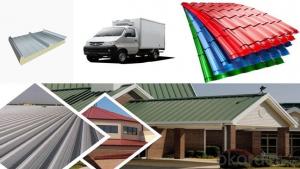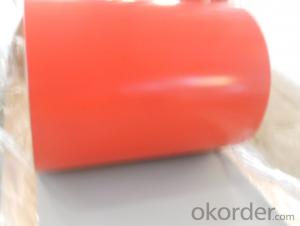Prepaint galvanized steel coil china suppliers offer
- Loading Port:
- Tianjin
- Payment Terms:
- TT OR LC
- Min Order Qty:
- 25 m.t.
- Supply Capability:
- 26711 m.t./month
OKorder Service Pledge
OKorder Financial Service
You Might Also Like
Specification
Prepaint galvanized steel coil china suppliers offer
Pre-Painted Galvanised Steel (PPGI) is a metallic coated steel product with improved corrosion resistance
where the premium range PPGI also include features such as dirt staining resistance, color retention, scratch
resistance (ScratchCore™) and solar reflectance (HeatBounce™). PPGI is commonly used in building materials
such as roofing, cladding, walling, and etc.
Main Features of the Pre-Painted Galvanized/Aluzinc Steel Coil:
• Excellent process capability
• Smooth and flat surface
• Workability, durability
• Excellent heat resistance performance
• High strength
• Good formability
• Good visual effect
Colors
All types of colors available as per RAL codes mainly White, Red, Blue, Green, Cream, Orange and various others.
Standard and Grade :
Pre-paint galvanized steel coil | ||||
ASTM A755M-03 | EN10169:2006 | JISG 3312-2012 | ||
Commercial quality | CS | DX51D+Z | CGCC | |
Structure steel | SS GRADE 230 | S220GD+Z | CGC340 | |
SS GRADE 255 | S250GD+Z | CGC400 | ||
SS GRADE 275 | S280GD+Z | CGC440 | ||
SS GRADE 340 | S320GD+Z | CGC490 | ||
SS GRADE550 | S350GD+Z | CGC570 | ||
S550GD+Z | ||||
Application :
Outdoor | Roof, roof structure, surface sheet of balcony, frame of window, door of garage, rolled shutter door, booth, Persian blinds, cabana, etc |
Indoor | Door, isolater, frame of door, light steel structure of house, home electronic appliances, ect. |






Packing:
Packaging Detail | The packing of coil consists of anti-damp paper ,PVC film ,hardboard paper , steel box , strapped with steel strips, fitted with locks and edge protectors and guarantees the optimal condition of the delivered goods. Each coil can be additionally fitted with wooden/steel skids(eye of the side) or wooden pallets(eye of the sky) |
Delivery Time | within 30 days of receipt of LC original or prepayment |



Our Service
MOQ | FCL, 25 metric tons per 20GP, can be assorted with different sizes. |
LCL for trial order is acceptable. | |
Price Term | EX-WORK, FOB China Port, CNF, CIF |
Payment | T/T, 30% advanced payment before production and balance before shipment; OR Irrevocable L/C at sight. |
Delivery Time | within 30 days of receipt of LC original or prepayment |
FAQ:
1. What’s the application of this product?
Roof, roof structure, surface sheet of balcony, frame of window, etc.
2. What’s the brand of the paint?
We use the best brand of all of the word—AKZO.
3. How to guarantee the quality of the products?
We have established the international advanced quality management system,every link
from raw material to final product we have strict quality test;We resolutely put an end to
unqualified products flowing into the market. At the same time, we will provide necessary
follow-up service assurance.
4. How long can we receive the product after purchase?
Usually within thirty working days after receiving buyer’s advance payment or LC. We will arrange
the factory manufacturing as soon as possible. The cargo readiness usually takes 15-25 days, but
the shipment will depend on the vessel situation
- Q: What are the different coil leveling methods used for steel coils?
- Steel coils can be leveled using various methods, each with its own advantages and limitations. Here are some commonly used methods: 1. Roller Leveling: Coils pass through rollers that apply pressure to flatten and level them. This method is effective in reducing coil crown or center buckle and eliminating coil memory. However, it may not be suitable for coils with severe shape defects or variations. 2. Stretch Leveling: Coils are stretched to remove shape defects. Gripper heads hold the edges of the coil while it is stretched. Stretch leveling is particularly effective in correcting crossbow and edge wave defects. However, it may cause elongation and yield loss in the material. 3. Temper Pass: Coils go through temper mill stands, where tension and compression forces are applied. Temper pass leveling improves flatness and removes coil memory. It is commonly used for thinner gauge steel coils but may not be suitable for thicker coils. 4. Corrective Leveling: This method is used for coils with severe shape defects. Skilled operators selectively remove material from specific areas of the coil to correct the shape. Corrective leveling effectively eliminates shape defects and improves flatness but requires significant labor. 5. Tension Leveling: Coils undergo tension forces while passing through pinch rolls. Tension leveling removes coil memory and improves flatness, especially for coils with edge wave defects. However, it may cause elongation and yield loss in the material. These are just a few of the coil leveling methods used for steel coils. The choice of method depends on specific requirements and desired flatness results. Considerations such as material thickness, shape defects, and production capacity are important in selecting the appropriate leveling method.
- Q: I looking at replacing a few of the panels on my car with either Carbon Fiber or High Tensile Steel to shave off some weight and increase mpg and take some time off my quarter mile. Which is better: Carbon Fiber or High Tensile Steel?
- Steel is much cheaper to buy, but weighs more than the carbon fiber and is not as strong as a rule. To save weight on a race car go with carbon fiber. To save weight (money) on the wallet go with steel.
- Q: I am buying my boyfriend a steel guitar for our one year anniversary and I was curious what brand or company I should look into. I want something high quality yet traditional. Money is not really an issue but I don't exactly want to spend an arm and a leg either.Thank you in advance!
- Did Steel Guitar stand for guitar string ? If yes, there's many brand provide quality guitar string and also be famous brand. you can buy such as D'addario, Errnie ball, GHS, Blue Steel. One more tips, for standard string gauge, if you want to surprise your boyfriend, buy .9 or .10 gauge set. This string set suitable for standard guitar, He'll be more happy if you give him 1 pack of string, buy if it over your price range, just 1 set is ok, haha. Happy Anniversary, Es. ;)
- Q: How are steel coils used in the production of steel cables?
- Steel coils are used in the production of steel cables by being uncoiled and straightened, then fed into a machine that twists and braids them together to create the cable.
- Q: What are the different types of steel coil cutting machines?
- There are several different types of steel coil cutting machines, including slitting machines, shearing machines, and laser cutting machines. Slitting machines are used to cut the steel coil into narrow strips, while shearing machines cut the coil into smaller, more precise lengths. Laser cutting machines use a high-powered laser beam to cut through the steel coil with extreme accuracy. Each type of machine has its own advantages and is suited for specific cutting requirements.
- Q: What are the common coil inspection techniques?
- Some common coil inspection techniques include visual inspection, magnetic particle inspection, eddy current testing, and ultrasonic testing.
- Q: I know there is soft steel and sturdier steel they use in products. The sturdier often used for equipment that requires more durability when in operation.
- harder steel has a higher carbon and chromium content
- Q: What are the common storage defects in steel coils?
- Common storage defects in steel coils include corrosion, rusting, surface damage (such as scratches or dents), coil slippage or misalignment, coil edge damage, and moisture or water damage. These defects can occur due to improper storage conditions, handling, or exposure to environmental factors. Regular inspection and proper storage practices are essential to prevent these defects and maintain the quality of steel coils.
- Q: Are Steel Building Kits really helpful while erecting a steel building?
- I put up a 30'x40' Mueller Steel Building from a bolt together kit 6 yrs ago. Fully insulated, 2 10'x10' roll up doors, 1 walk thru door, 3 windows, 2' overhang all around, and gutters. The building price minus the slab was about $9500. The only special equipment was a neighbor's large Farmall with a hay spike on the FEL that we used to lift the trusses in place. Then it was mainly cordless drills to put in LOTS of self tapping screws, circular saw with metal cutting blade, tall ladders, etc. Had help putting up the trusses and putting up the roof panels. Everything else I did by myself. Took about 6 wks, but that was only working weekends and maybe 3 evenings a week since that land is 30 miles from my house. Would have gone a lot faster with at least one helper.
- Q: How are steel coils used in the manufacturing of industrial pumps?
- Steel coils are used in the manufacturing of industrial pumps as a primary material for constructing the pump casing, impellers, and other critical components. The steel coils are first uncoiled and then cut into specific shapes and sizes, which are then formed, welded, and machined to create the various parts of the pump. The strength, durability, and corrosion resistance of steel make it an ideal choice for ensuring the longevity and reliability of industrial pumps in demanding applications.
Send your message to us
Prepaint galvanized steel coil china suppliers offer
- Loading Port:
- Tianjin
- Payment Terms:
- TT OR LC
- Min Order Qty:
- 25 m.t.
- Supply Capability:
- 26711 m.t./month
OKorder Service Pledge
OKorder Financial Service
Similar products
Hot products
Hot Searches
Related keywords


























